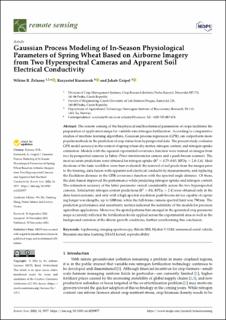| dc.contributor.author | Żelazny, Wiktor R. | |
| dc.contributor.author | Kusnierek, Krzysztof | |
| dc.contributor.author | Geipel, Jakob | |
| dc.date.accessioned | 2022-12-27T14:29:03Z | |
| dc.date.available | 2022-12-27T14:29:03Z | |
| dc.date.created | 2022-11-28T13:25:20Z | |
| dc.date.issued | 2022-11-25 | |
| dc.identifier.citation | Remote Sensing. 2022, 14 (23), 1-28. | en_US |
| dc.identifier.issn | 2072-4292 | |
| dc.identifier.uri | https://hdl.handle.net/11250/3039581 | |
| dc.description.abstract | The remote sensing of the biophysical and biochemical parameters of crops facilitates the preparation of application maps for variable-rate nitrogen fertilization. According to comparative studies of machine learning algorithms, Gaussian process regression (GPR) can outperform more popular methods in the prediction of crop status from hyperspectral data. The present study evaluates GPR model accuracy in the context of spring wheat dry matter, nitrogen content, and nitrogen uptake estimation. Models with the squared exponential covariance function were trained on images from two hyperspectral cameras (a frenchFabry–Pérot interferometer camera and a push-broom scanner). The most accurate predictions were obtained for nitrogen uptake (R2=0.75–0.85, RPDP=2.0–2.6). Modifications of the basic workflow were then evaluated: the removal of soil pixels from the images prior to the training, data fusion with apparent soil electrical conductivity measurements, and replacing the Euclidean distance in the GPR covariance function with the spectral angle distance. Of these, the data fusion improved the performance while predicting nitrogen uptake and nitrogen content. The estimation accuracy of the latter parameter varied considerably across the two hyperspectral cameras. Satisfactory nitrogen content predictions (R2>0.8, RPDP>2.4) were obtained only in the data-fusion scenario, and only with a high spectral resolution push-broom device capable of capturing longer wavelengths, up to 1000 nm, while the full-frame camera spectral limit was 790 nm. The prediction performance and uncertainty metrics indicated the suitability of the models for precision agriculture applications. Moreover, the spatial patterns that emerged in the generated crop parameter maps accurately reflected the fertilization levels applied across the experimental area as well as the background variation of the abiotic growth conditions, further corroborating this conclusion. | en_US |
| dc.language.iso | eng | en_US |
| dc.publisher | MDPI | en_US |
| dc.rights | Navngivelse 4.0 Internasjonal | * |
| dc.rights.uri | http://creativecommons.org/licenses/by/4.0/deed.no | * |
| dc.title | Gaussian Process Modeling of In-Season Physiological Parameters of Spring Wheat Based on Airborne Imagery from Two Hyperspectral Cameras and Apparent Soil Electrical Conductivity | en_US |
| dc.title.alternative | Gaussian Process Modeling of In-Season Physiological Parameters of Spring Wheat Based on Airborne Imagery from Two Hyperspectral Cameras and Apparent Soil Electrical Conductivity | en_US |
| dc.type | Peer reviewed | en_US |
| dc.type | Journal article | en_US |
| dc.description.version | publishedVersion | en_US |
| dc.rights.holder | © 2022 by the authors | en_US |
| dc.source.pagenumber | 1-28 | en_US |
| dc.source.volume | 14 | en_US |
| dc.source.journal | Remote Sensing | en_US |
| dc.source.issue | 23 | en_US |
| dc.identifier.doi | 10.3390/rs14235977 | |
| dc.identifier.cristin | 2082648 | |
| dc.relation.project | Interreg: 001171 | en_US |
| dc.source.articlenumber | 5977 | en_US |
| cristin.ispublished | true | |
| cristin.fulltext | original | |
| cristin.qualitycode | 1 | |

